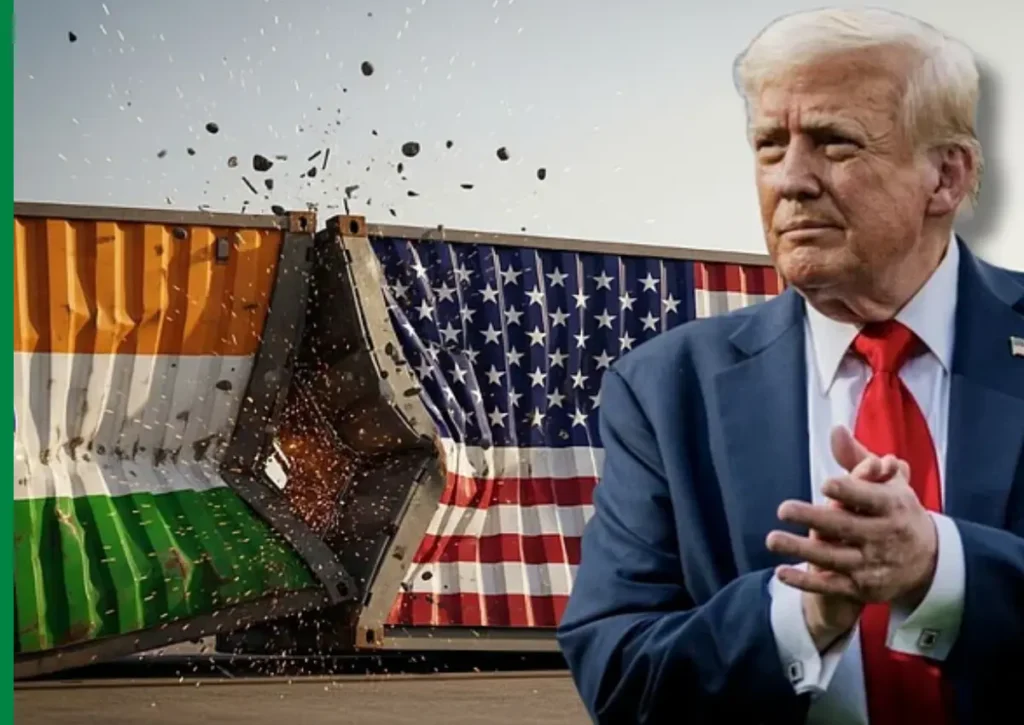In a major trade-related escalation, US President Donald Trump has slapped an aggressive 50 percent tariff on Indian exports, one of the harshest trade actions against India that has happened so far. Made August 6, 2025, scaling a previous tariff announced on July 31, 2025 of 25 percent, the organizations lay an additional 25 percent levy specifically against India, still importing Russian oil despite the geopolitical tension that existed at the time.
What is behind Trade Action based on Trump?
These unprecedented tariffs on India by Trump seem calculated to twist the arm of Moscow into a ceasefire in the Ukraine confrontation. Being the second buyer of Russian oil in the world, India is caught in the crosshairs of US foreign policy goals. This had been reduced to 12 days up to Friday, August 8, 2025, by the American administration, who first had given Russia a time of 50 days to agree to a ceasefire.

The tariffs can be viewed as a trade matter but it is more than that; it is all about the intricate geopolitical situation in which economic ties experience a series of interactions with various security issues that are global in nature. The government of Trump has shown that it is ready to use economic pressure when it comes to his foreign policy aims by declaring the imposing of so-called secondary sanctions on the nations who traded with Russia.
Immediate Market Reactions and Economic Consequences
The announcement has rocked the Indian financial markets and the economy of the world. Indian equity benchmark indices, Sensex and Nifty, dropped considerably in the opening trading session, whereas the leading BSE Sensex lost 242.24 points or 0.30 percent, to 80,381.02 points. The investors are those Foreign Institutional Investors and they sold equities to the tune of Rs 4,997.19 crore and the reason is that the foreign investors fear that any negative effect of the trade tussle could take place.
Major American retailers such as Amazon, Walmart, and Target have already started the process of canceling orders with India and exporters have been sent and received letters and emails asking them to halt shipments of apparel and textiles until further warning. The dire business implications of the imposition of the tariff are emphasized by the immediate reaction of the big US corporations.
Tariffs have already hit the highest level in the United States that they have been at since the year 1922, and American consumers will now pay an average of 18.3 percent more on any imports—the biggest rate since 1934. Such a historical plan to increase trade protectionism is a watershed in the US trade policy in the Trump era.
Sector-Specific Impact Assessment
According to analysis by the Global Trade Research Initiative (GTRI), the 50% tariff will severely impact nine key product categories. Exports of shrimp, organic chemicals, apparel, and jewelry are expected to decline by 50-70%, representing what GTRI categorizes as “very high impact sectors.” The textiles and chemicals sectors, where India has traditionally excelled in US exports, face particularly challenging prospects.
The Firozabad glass industry in Uttar Pradesh exemplifies the localized impact of these trade measures. With nearly 70% of their exports destined for the US market, this renowned glass manufacturing hub faces a major crisis. Industry representatives express concern that the proposed tariff hike, scheduled to take effect within three weeks, will deliver a severe blow to their business operations already struggling with competition from low-cost Chinese products.
Despite the significant challenges, official estimates suggest the impact may be more contained than initially feared. The 50% tariff applies to exports worth approximately $40 billion to the US, representing only 4.8% of India’s total goods and services exports worldwide, which surpassed a record $820 billion in 2024-25.
India’s Official Response and Political Ramifications
Prime Minister Narendra Modi is scheduled to chair a crucial high-level Cabinet meeting to assess the tariff impact and formulate India’s response strategy. In his first public reaction, Modi declared that India would “never compromise” on the interests of its farmers and dairy sector, emphasizing his willingness to bear significant personal costs if necessary to protect national interests.
The Indian government has officially characterized the additional tariffs as “unfair, unjustified and unreasonable,” expressing deep disappointment over what it describes as a “misguided and discriminatory” action. This strong diplomatic language indicates India’s resolve to challenge the measures through appropriate channels.
Political opposition has seized upon the tariff imposition as evidence of diplomatic failure. Trinamool Congress leader Abhishek Banerjee criticized the BJP government’s foreign policy approach, calling the tariff hike a “diplomatic failure” that threatens to steer India’s economy into crisis.
Government Support Measures and Industry Response
Indian government is also said to be focusing support measures in the badly affected sectors as part of the mission of promotions of exports which was introduced in the recent budget. The commerce ministry has been consulting exporters in the textiles and chemicals sectors to check the impact and also look at potential support.
Business personalities and the leaders in the industry have given mixed reactions. Echoing Goyal, Zomato founder Deepinder Goyal focused in on the role that technology, defense, and ambition can play in ensuring that India becomes the worlds largest, most unapologetic superpower.
International Implications and UN Response
The tariff measures have drawn criticism from international organizations, with UN Secretary-General Antonio Guterres expressing being “disheartened” by Trump’s tariffs. Guterres has consistently maintained that “all trade wars are ruinous and need to be avoided,” expressing particular concern about the impact on the world’s poorest populations who will be most affected by higher tariffs.
The tariff dispute has broader implications for US-India strategic partnership, particularly given India’s important role in regional security architecture and Indo-Pacific strategy. Senior US Congressman Gregory Meeks has criticized President Trump’s punitive tariffs, warning they risk years of diplomatic and economic cooperation between the two nations.
Know Trade Negotiations and Future Prospects
President Trump has been categorical in saying that no trade talks with India are forthcoming until the present tariff clash is overcome. This tough talk gives an indication of the uncertainty that will last more months over bilateral trade ties, even after pledging to boost the bilateral trade to half a trillion U.S. dollars by 2030.
This is a test case of how economically resilient and diplomatic India would be. Though its short-term implication is not that problematic because India has a diversified export portfolio, the long-term effects on the relationship between the US and India and the trends of global trade are not insubstantial.
The response strategy that is expected to be implemented in India may include a mix of diplomatic action, domestic policies supporting industries that have to deal with the effects of the US trade war, and the possibility of diversifying channels of exports, thus decreasing reliance on trade partnerships with the USA.
With this trade issue developing, indeed, it is a sad reminder of how international economic relations are changeable so fast according to the factors and considerations related to the geopolitical aspects, thus, the interdependence of modern global trade and international relations.



